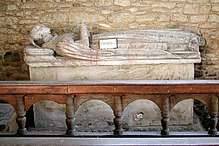Elizabeth Tyrwhitt
Elizabeth Tyrwhitt (died 1578), was an English gentlewoman, courtier, and writer.[1][2]
Origins
Born in her father's house at Brede, she was one of five children of Sir Goddard Oxenbridge (died 1531) and his second wife Anne (died 1531), widow of John Windsor and daughter of Sir Thomas Fiennes, of Claverham in Arlington (a son of Sir Richard Fiennes).[1]
Life
Accepted into the court of King Henry VIII, by 1537 she was a gentlewoman of the privy chamber and shortly after was married to a fellow-courtier.[1] After serving in the households of Queen Jane Seymour and Queen Catherine Howard,[3] she became lady-in-waiting and a close friend to Queen Catherine Parr.[4]
The two were related by marriage and shared Protestant sympathies. However, suspected of links to the executed Anne Askew, with other members of Catherine's household in 1546 she was arrested by the King. After his death, she remained in service with Catherine and her fourth husband, Thomas Seymour, being at the bedside when Catherine died in 1549.[1]
In the scandal which followed over Seymour's relationship with the future Queen Elizabeth I of England, she gave evidence over possibly inappropriate behaviour and was briefly placed in charge of the princess in place of the suspect Catherine Astley.[1][5][6][7]
Thereafter she lived a private life, dying at her home in Clerkenwell. Her will was proved on 28 April 1578 and she was buried in the church of St Mary the Virgin at Leighton Bromswold, where her effigy may be seen together with those of her husband and daughter.[1]

Writings
She composed a work called Morning and Evening Praiers, with Divers Psalmes Himnes and Meditations, published in 1574. A copy now in the British Library had belonged to Queen Elizabeth I and includes prayers written by Catherine Parr.[1][8][9]
Family
Between March 1538 and August 1539 she married, as his second wife, the courtier Sir Robert Tyrwhitt (died 1572), of Leighton Bromswold. (Her niece Elizabeth Oxenbridge, daughter of her half-brother Thomas, had previously married her husband's nephew, Sir Robert Tyrwhitt). They had one daughter Catherine (died 1567), who married Sir Henry Darcy of Brimham in Yorkshire.[1][10]
References
- 1 2 3 4 5 6 7 8 Brace, Patricia (January 2012), "Tyrwhit , Elizabeth, Lady Tyrwhit (d. 1578)", Oxford Dictionary of National Biography, Oxford University Press, retrieved 19 November 2017
- ↑ Profile of Lady Elizabeth Tyrwhitt by Kate Emerson, kateemersonhistoricals.com; accessed 1 May 2014.
- ↑ "A Who's Who of Tudor Women (O)". kateemersonhistoricals.com. Retrieved 14 January 2014.
- ↑ The Oxford Handbook of Tudor Literature: 1485–1603, page 224 (eds. Mike Pincombe and Cathy Shrank).
- ↑ Ross, J. (2011). The Men Who Would Be King: Suitors to Queen Elizabeth I. Orion. ISBN 9781780221946.
- ↑ Agnes Strickland; Strickland, E. (2010). Lives of the Queens of England from the Norman Conquest. Cambridge University Press. ISBN 9781108019729.
- ↑ "Confession of Elizabeth Tyrwhitt". tudorqueen6.wordpress.com. Retrieved 14 January 2014.
- ↑ p.225, The Oxford Handbook of Tudor Literature: 1485–1603 ed. Mike Pincombe and Cathy Shrank.
- ↑ Tyrwhitt, E.; Felch, S.M. (2008). Elizabeth Tyrwhitt's Morning and Evening Prayers. Ashgate Pub. Company. ISBN 9780754606611.
- ↑ "TYRWHITT, Sir Robert I (by 1504-72), of Mortlake, Surr. and Leighton Bromswold, Hunts. – History of Parliament Online". historyofparliamentonline.org. Retrieved 14 January 2014.